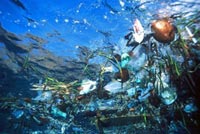 Yesterday, we posted about a beach where the ocean has worn down glass, which once had been discarded as trash. The “glass beach” is now beautiful and enjoyed by thousands. If only all our trash was glass.
Yesterday, we posted about a beach where the ocean has worn down glass, which once had been discarded as trash. The “glass beach” is now beautiful and enjoyed by thousands. If only all our trash was glass.
Another beach comes to mind on Palmyra Atoll, a tropical atoll in almost the geometric center of the Pacific Ocean. It should be the image of an island paradise. Instead, the beach resembles more of a trash heap. From the Palmyra Atoll Wikipedia page: Palmyra Atoll’s location in the Pacific Ocean, where the southern and northern currents meet, means that its beaches are littered with trash and debris. Plastic mooring buoys and plastic bottles are plentiful on the beaches of Palmyra.
In today’s New York Times, Captain Charles J. Moore, founder of the Algalita Marine Research and Education Institute in Long Beach, California, writes of a recent six week voyage he took with a team of scientists conducting research in the Great Pacific Garbage Patch — one of five major garbage patches drifting in the oceans north and south of the equator.
He writes: “Although it was my 10th voyage to the area, I was utterly shocked to see the enormous increase in the quantity of plastic waste since my last trip in 2009. Plastics of every description, from toothbrushes to tires to unidentifiable fragments too numerous to count floated past our marine research vessel Alguita for hundreds of miles without end. We even came upon a floating island bolstered by dozens of plastic buoys used in oyster aquaculture that had solid areas you could walk on.”
He goes on to say, in part: Plastics are a nightmare to recycle. They are very hard to clean. They can melt at low temperatures, so impurities are not vaporized. It makes no difference whether a synthetic polymer like polyethylene is derived from petroleum or plants; it is still a persistent pollutant. Marine degradable plastics exist, but manufacturers are quick to point out that marine degradable does not mean “marine disposable.”
Scientists in Britain and the Netherlands have proposed to cut plastic pollution by the institution of a “circular economy.” The basic concept is that products must be designed with end-of-life recovery in mind. They propose a precycling premium to provide incentives to eliminate the possibility that a product will become waste.
In the United States, especially in California, the focus has been on so-called structural controls, such as covering gutters and catch basins with 5-millimeter screens. This has reduced the amount of debris flowing down rivers to the sea. Activists around the world are lobbying for bans on the most polluting plastics — the bottles, bags and containers that deliver food and drink. Many have been successful. In California, nearly 100 municipalities have passed ordinances banning throwaway plastic bags and the Senate is considering a statewide ban.
Until we shut off the tap of vagrant plastics flowing to the sea, which is downhill from virtually everywhere, we will continue to play a game of catch-up with the newest global threat to the Anthropocene age in which we live.
To read the full essay, click here: Choking the Oceans With Plastic

Pingback: Scheepvaartnieuws | Bootjesgek.nl
No matter how many cry, complain, worry of Bxxxh about this, it will never go away and never stop growing. Ever!
Everytime a major storm, flood, Tsunami, Cyclone, hurricane, water spout, Tornado, ship sinking, pleasure craft sinking, or plain crashes, you will have this junk end up in the oceans, two in the north Pacific at least one in the North Atlantic and who really knows what south of the equator has?
The trash is there and its never going to stop or go away.
Everybody that is worried amd wants to complain about it should just stop and realize that its not changing.